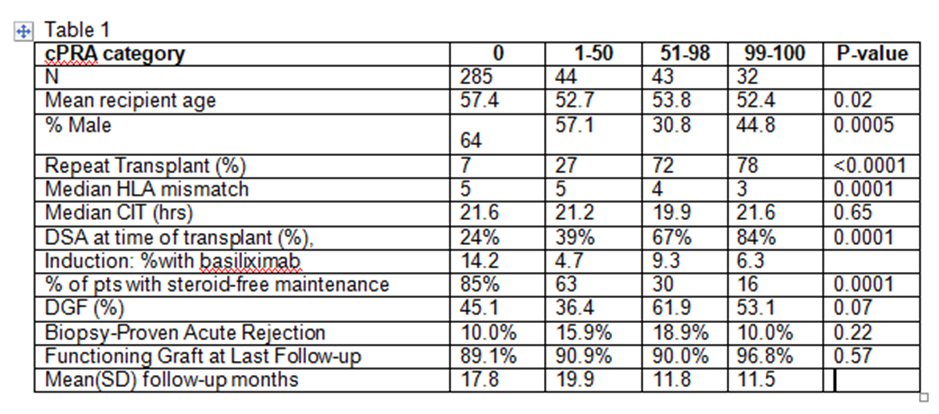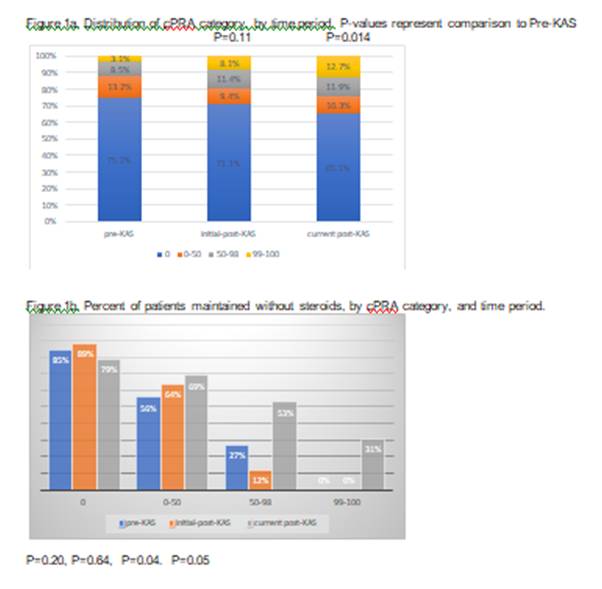Optimizing Opportunity and Benefits of Steroid Avoidance in the New KAS Era
New York Presbyterian / Weill Cornell, New York, NY
Meeting: 2019 American Transplant Congress
Abstract number: A275
Keywords: Allocation, Kidney transplantation, Panel reactive antibodies
Session Information
Session Name: Poster Session A: Kidney Immunosuppression: Novel Regimens and Drug Minimization
Session Type: Poster Session
Date: Saturday, June 1, 2019
Session Time: 5:30pm-7:30pm
 Presentation Time: 5:30pm-7:30pm
Presentation Time: 5:30pm-7:30pm
Location: Hall C & D
*Purpose: The introduction of the new Kidney Allocation System (KAS) in 2014 has facilitated transplantation of sensitized patients with high CPRA. However, the CPRA value depends on the parameters for listing unacceptable antigens and these parameters vary by center. Upon review of our initial experience, our center implemented a more conservative approach for listing unacceptable antigens in 3/2017 and therefore we aimed to evaluate the impact of this approach on transplant rates and outcomes and the use of steroid-avoidance immunosuppression.
*Methods: We performed a retrospective review of all kidney transplants at our institution between 1/1/2013 and 10/30/2018. We divided patients according to sensitization status – non-sensitized (cPRA 0), mildly sensitized (cPRA 1-50), moderately sensitized (cPRA 51-98), and highly sensitized (cPRA 99-100) – in the three distinct time periods: pre-KAS (1/1/13 – 12/3/14), initial post-KAS (12/4/14 – 2/28/17) where we used 10,000 MFI to list unacceptable antigens, and current post-KAS (3/1/17 – 10/31/18) where we used 4,000 MFI to list unacceptable antigens. Patients without DSA were maintained steroid-free.
*Results: Table 1 demonstrates the recipient characteristics according to CPRA status for the entire cohort. Figure 1a demonstrates the increased transplant rate of sensitized patients in the initial and current post-KAS era compared to pre-KAS. Figure 1b demonstrates the increased utilization of steroid avoidance immunosuppression in the current post-KAS era. For patients with CPRA>50%, 14% of patients did not have DSA at time of transplant in the initial post-KAS period while 30% did not have DSA in the current post-KAS period.Comparing all patients who were steroid-free versus steroid-maintenance, the outcomes were similar: overall graft-survival was 90.9% versus 89.1%, and the average creatinine was 1.73 versus 1.51.
*Conclusions: Our data confirm the increase in transplant rate of sensitized patients under the new-KAS system. In addition, we demonstrate that the use of a more conservative approach for listing unacceptable antigens facilitates improved recipient-donor compatibility as evidenced by lack of DSA at time of transplantation and the use of steroid-avoidance protocols.
To cite this abstract in AMA style:
Sultan S, Aull M, Friedlander R, Sharma VK, Serur D, Watkins A, Kapur S, Dadhania D. Optimizing Opportunity and Benefits of Steroid Avoidance in the New KAS Era [abstract]. Am J Transplant. 2019; 19 (suppl 3). https://atcmeetingabstracts.com/abstract/optimizing-opportunity-and-benefits-of-steroid-avoidance-in-the-new-kas-era/. Accessed December 25, 2025.« Back to 2019 American Transplant Congress


